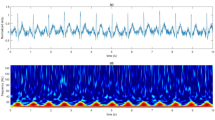Abstract
Noise of certain characteristics can efficiently be extracted from a multilead physiological record. This paper presents a novel method for distilling random components of electrocardiogram. First, the algorithm calculates first principal component of the record as a noise-reduced reference. Next, a multiplication-addition network is trained and used for prediction of the value in each given lead based on remaining leads. Finally, the time series of prediction errors are decorrelated with the noise-reduced reference, what removes the geometry-related component of unexpectedness. In tests with poor electrode contact and muscle fibrillation noise patterns, the method shows static noise estimation accuracy of 80.3 % and 84 % respectively and in dynamic tests - the accuracy of 78.1% and 82.6%, what outperforms other known methods.
Access this chapter
Tax calculation will be finalised at checkout
Purchases are for personal use only
Similar content being viewed by others
References
Augustyniak, P.: Time-frequency modelling and discrimination of noise in the electrocardiogram. Physiol. Meas. 24(3), 753–767 (2003)
Augustyniak, P.: Instantaneous measurement of SNR in electrocardiograms based on quasi-continuous time-scale noise modeling. In: Burduk, R., et al. (eds.) Computer Recognition Systems 4, 2011. Advances in Intelligent and Soft Computing, vol. 95, pp. 529–538. Springer, Berlin (2011)
Augustyniak, P.: Localization of noise sources in a multilead electrophysiological record. In: Augustyniak, P., et al. (eds.), Recent Developments and Achievements in Biocybernetics and Biomedical Engineering, Advances in Intelligent Systems and Computing, vol. 647. Springer, Berlin (2018). https://doi.org/10.1007/978-3-319-66905-25
Butt, M.M., Akream, U., Khan, S.A.: Denoising practices for electrocardiographic (ECG) signals: a survey. In: 2015 International Conference on Computer, Communications, and Control Technology (2015). https://doi.org/10.1109/I4CT.2015.7219578
Dreyfus, S.E.: Artificial neural networks, back propagation, and the Kelley-Bryson gradient procedure. J. Guid. Control Dyn. 13(5), 926–928 (1990)
Linsker, R.: Self-organization in a perceptual network. IEEE Comput. 21(3), 105–117 (1988)
Macfarlane, P.W., Lawrie, T.D.V. (eds.): Comprehensive Electrocardiology: Theory and Practice in Health and Disease, 1st edn., vol. 1, 2, and 3, pp. 1785. Pergamon Press, New York (1989)
Nikolaev, N., Gotchev, A., Egiazarian, K., Nikolov, Z.: Suppression of electromyogram interference on the electrocardiogram by transform domain denoising. Med. Biol. Eng. Comput. 39, 649–655 (2001)
Moody, G.B.: The MIT-BIH Arrhythmia Database CD-ROM, 3rd edn. Harvard-MIT Division of Health Sciences and Technology (1997)
van Oosterom, A., Oostendorp, T.F.: ECGSIM: an interactive tool for studying the genesis of QRST waveforms. Heart 90, 165–168 (2004)
Paul, J., Reedy, M., Kumar, V.: A transform domain SVD filter for suppression of muscle noise artefacts in exercise ECG’s. IEEE Trans. Biomed. Eng. 47, 645–662 (2000)
Singh, G., Kaur, G., Kumar, V.: ECG denoising using adaptive selection of IMFs through EMD and EEMD. In: International Conference on Data Science & Engineering (ICDSE) (2014). https://doi.org/10.1109/ICDSE.2014.6974643
Acknowledgement
This scientific work is supported by the AGH University of Science and Technology in year 2019 from the subvention granted by the Polish Ministry of Science and Higher Education.
Author information
Authors and Affiliations
Corresponding author
Editor information
Editors and Affiliations
Rights and permissions
Copyright information
© 2019 Springer Nature Switzerland AG
About this paper
Cite this paper
Augustyniak, P. (2019). Pointwise Estimation of Noise in a Multilead ECG Record. In: Pietka, E., Badura, P., Kawa, J., Wieclawek, W. (eds) Information Technology in Biomedicine. ITIB 2019. Advances in Intelligent Systems and Computing, vol 1011. Springer, Cham. https://doi.org/10.1007/978-3-030-23762-2_41
Download citation
DOI: https://doi.org/10.1007/978-3-030-23762-2_41
Published:
Publisher Name: Springer, Cham
Print ISBN: 978-3-030-23761-5
Online ISBN: 978-3-030-23762-2
eBook Packages: Intelligent Technologies and RoboticsIntelligent Technologies and Robotics (R0)




